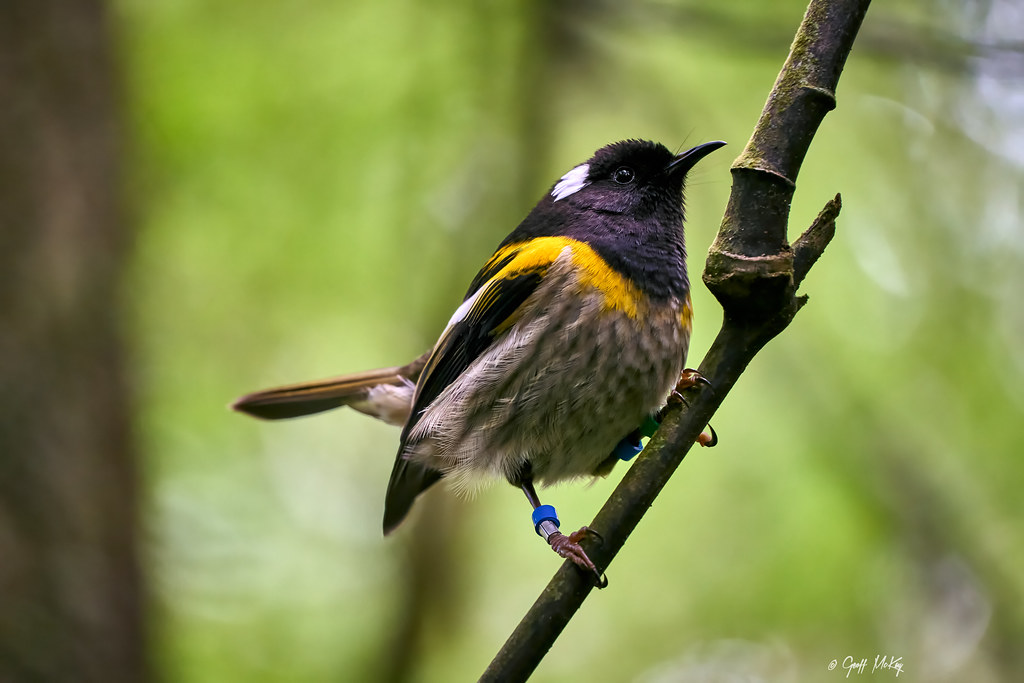Media release
From:
Wild animals may be able to evolve faster than scientists thought
How fast can wild animals adapt? Faster than previously thought, it seems, based on a global study examining rates of evolution in 15 species, including the threatened Aotearoa New Zealand hihi (stitchbird).
A higher genetic contribution to differences in individual survival and reproduction means animal species can adapt more rapidly. This “fuel” of evolution may exist in wild animal populations at two to four times the rate previously thought, the study suggests, potentially aiding species’ odds of survival.
The study, just published in the journal Science, was led out of Australian National University by Dr Timothée Bonnet and Dr Anna Santure, of Waipapa Taumata Rau – University of Auckland, was among the co-authors.
New statistical methods were applied to data relating to 19 populations of wild animals around the world, including superb fairy-wrens in Australia, spotted hyenas in Tanzania, song sparrows in Canada and red deer in Scotland. The data pointed to the contribution of genes versus environment in the ability of species to survive and reproduce.
The research showed that the majority of the 19 wild animal populations were able to adapt rapidly.
“Hihi are one of the unluckier species, with a lower capacity to adapt,” says Dr Santure. “However, this research suggests that many species can adapt quickly, provided they’re not totally outpaced by habitat loss and climate change.”
“For hihi, the analysis matches previous work that we’ve done suggesting a low capacity to adapt, but they can be buffered from extinction by conservation management actions such as provisioning food and parasite and predator control.”
The individual studies contributing to the research had been running for an average of nearly 30 years each, generating a remarkable resource of detailed records on wild animal populations.
For hihi, two datasets, from populations on Tiritiri Matangi island and at Zealandia Sanctuary, represented a combined 31 years and 90,000 hours of fieldwork from dedicated conservation staff, volunteers and students. The populations have been intensively studied since they were re-established, with breeding and survival data available for every bird.
Evolution can proceed extremely slowly, but changes can also occur within just a few years and are now more easily detected by scientists after advances in genetics and statistics.
Species introduced to Aotearoa New Zealand have provided examples of rapid adaptation to conditions very different than their native habitats. For example, weasels are generally larger than the European populations they came from.
In addition, ‘artificial’ (human-directed) selection causes considerable and rapid change in many domesticated and farmed species of animals.
Expert Reaction
These comments have been collated by the Science Media Centre to provide a variety of expert perspectives on this issue. Feel free to use these quotes in your stories. Views expressed are the personal opinions of the experts named. They do not represent the views of the SMC or any other organisation unless specifically stated.
Dr John Ewen, Co-Chair, Hihi Recovery Group
This study is critically important. Our precious hihi contrast with other species investigated by having more limited capacity to adapt, but this also highlights how our efforts to help them are working in spite of this.
Over the last 30 years we have honed our support, improving translocation techniques to establish new populations and the help these hihi populations then need to thrive, including provisioning food and providing them protection from parasites and predators. This has resulted in a tremendous growth from one to seven populations. We continue to invest heavily in studying each population and apply this knowledge to continuously improve our conservation work. Along the way we also shed light on perhaps the most charismatic of New Zealand’s forest birds, a species critical to forest health and one that needs our help to continue its recovery as this study reveals.
Dr Anna Santure, Senior Lecturer, School of Biological Sciences, University of Auckland
How fast can populations adapt? It seems faster than we previously thought, based on a large global study examining rates of evolution in 15 different species, including the threatened Aotearoa New Zealand hihi (stitchbird). The study used long-term data – spanning over 2.6 million hours of fieldwork study across species – to determine the contribution of genes versus environment to differences in the ability of individual animals to survive and reproduce. A higher genetic contribution to survival and reproduction means that populations are more able to rapidly adapt to new selection pressures.
Where previous studies across species had suggested that the ability to adapt was very limited for many species, in this study, applying new statistical methods, most species showed capacity to rapidly respond to selection, which in turn puts them at a lower risk of extinction.
The hihi team that I work with are delighted to add their very precious hihi datasets to this global analysis. Two of our reintroduced hihi populations – on Tiritiri Matangi Island in the Hauraki Gulf, and Zealandia wildlife sanctuary in Wellington - have been intensively studied since they were established, which means breeding and survival data is available for every bird. The new analysis agrees with the previous analysis our team have done for hihi, which suggested they have low capacity to adapt but are buffered from extinction by conservation management actions such as provisioning food and parasite and predator control.
However, the general finding from this new global research was optimistic for the ability of many other threatened species to adapt, particularly if habitat loss and climate change can be slowed from their current increasingly fast rates of change.



 Australia; New Zealand; International
Australia; New Zealand; International



